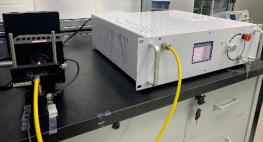[ Instrument Network Instrument Development ] Recently, Shanghai Optical Machinery Institute's high-power laser unit technology laboratory has made progress in the research of nanosecond and picosecond all-fiber supercontinuum lasers.
Researchers have built a variety of engineering prototypes based on self-drawn high-linearity photonic crystal fibers and self-developed ultrafast laser pump sources, combined with self-developed high-efficiency fusion coupling technology of small core diameter and high nonlinear fiber. An all-fiber nanosecond supercontinuum laser and a picosecond supercontinuum laser are available. By adjusting the internal microstructure of the self-developed high nonlinear photonic crystal fiber, the output wavelength distribution of the laser can be adjusted. The output spectral range of both supercontinuum lasers covers both the visible and near-infrared bands.
Supercontinuum laser is a high-intensity ultra-wideband laser source, which has important applications in biomedical imaging, hyperspectral technology, ultrafast spectral analysis and other technical fields. In general, an ultrashort pulse laser with high peak power is coupled into a highly nonlinear fiber, and the various nonlinear effects of the fiber are used to greatly broaden the spectrum of the output light, thereby achieving an ultra-wide spectral output.
The output power of the two supercontinuum lasers is stable and the spectrum covers 400-2400 nm, which is in the forefront of "supercontinuum source" at home and abroad. Among them, the pulse width and visible light power density of picosecond "supercontinuum light source" fill the domestic gap. The nanosecond supercontinuum laser has an average power of 5 W, a repeatable frequency range of 0.02-1 MHz, and a pulse width adjustable range of 6-200 ns. The picosecond supercontinuum laser has an average power of 5 W, a repeatable frequency range of 20-60 MHz, and a pulse width output of 10 ps.
(Original title: Progress in nanosecond and picosecond all-fiber supercontinuum lasers at Shanghai Opto-mechanical Institute)
Ceramic Hybrid Bearings have Steel races and Ceramic Balls. Ceramic Balls are suitable for applications where high loads, high speeds and extreme temperatures are factors. Long life and the need for minimal lubrication make this material appropriate for extreme applications. Ceramic is non-porous, non-magnetic, non corrosive and lighter than steel. In ball form, ceramic balls are also harder than steel and because ceramic balls are non-porous they are virtually frictionless and capable of spinning faster than steel balls.
Ceramic Balls are usually made of following materials:
Silicon Nitride (SiN4)
Alumina Oxide (Al2O3)
Zirconia Oxide (ZrO2)
Silicon Carbide (SiC)
Because ceramic is a glass like surface it has an extremely low coefficient of friction and is ideal for applications seeking to reduce friction. Ceramic balls require less lubrication and have a greater hardness than steel balls which will contribute to increased bearing life. Thermal properties are better than steel balls resulting in less heat generation at high speeds.
Ceramic Bearings
Ceramic Bearings,Ceramic Ball Bearings,Hybrid Ceramic Bearing,Hybrid Ceramic Ball Bearings
Ningbo Ritbearing Imp & Exp Co.,Ltd. , https://www.nbbearing.de
